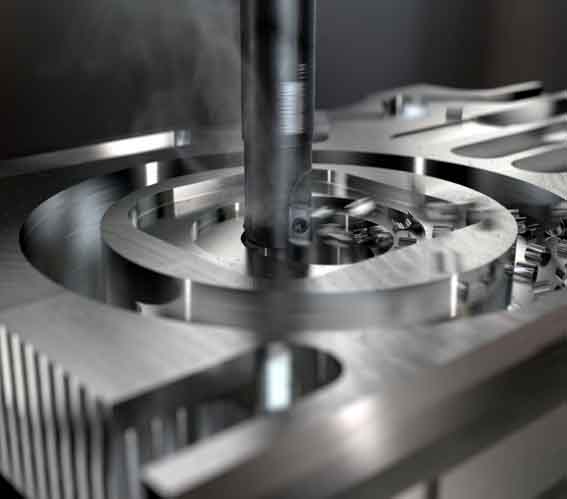마진이 큰 알루미늄 부품의 CNC 가공용 (크기가 큰, 얇은 벽으로 둘러싸인, 알루미늄 캐비티 부품), 가공 공정 중 더 나은 방열 조건을 유지하고 열 집중을 피하기 위해, 가공 중에 대칭 가공을 사용해야 합니다.. 90mm 두께의 알루미늄 시트를 60mm로 가공해야 하는 경우, 한쪽이 밀링된 경우, 반대쪽은 즉시 밀링해야 합니다., 평탄도는 한 번에 최종 크기로 가공한 후 5mm에 도달할 수 있습니다.;
반복 이송 대칭 처리를 사용하는 경우, 각 면은 최종 크기로 두 번 처리됩니다., 평탄도는 0.3mm까지 보장됩니다..
2. If multiple cavities are processed on aluminum alloy sheet parts, it is not advisable to use the sequential processing method from one cavity to one cavity during processing. This will easily cause the parts to be deformed due to uneven force. 다층 처리가 채택됩니다., and each layer is processed to all cavities at the same time as possible. Then process the next layer of all cavities to make the parts evenly stressed and reduce deformation.
3. Reduce cutting force and cutting heat by changing the cutting and milling thickness. Among the three elements of cutting amount, milling thickness has a great influence on cutting force. 가공 여유가 너무 큰 경우, 한 패스의 절삭력이 너무 큽니다., 부품을 변형시킬 뿐만 아니라, 뿐만 아니라 공작 기계 스핀들의 강성에 영향을 미치고 공구의 내구성을 저하시킵니다.. If the thickness of the milling is reduced, 생산 효율성이 크게 저하됩니다.. 하지만, CNC 가공의 고속 밀링은 이 문제를 극복할 수 있습니다.. While reducing the depth of milling, as long as the feed is correspondingly increased and the speed of the machine tool is increased, 가공 효율성을 보장하면서 절삭력을 줄일 수 있습니다..
4. The cutting sequence of milling should also be paid attention to. 황삭 가공은 가공 효율성 향상과 단위 시간당 제거율 추구를 강조합니다.. 일반적으로, up-milling can be used. 그건, 블랭크 표면의 과잉 재료는 가장 빠른 속도와 최단 시간으로 제거됩니다., 마무리에 필요한 기하학적 윤곽이 기본적으로 형성됩니다.. 마무리의 강조점은 높은 정밀도와 높은 품질입니다., 다운 밀링을 사용해야 합니다.. 다운밀링시 커터날의 절삭두께가 최대치에서 0까지 점차 감소하기 때문에, 가공 경화 정도가 크게 감소합니다., 동시에 부품의 변형 정도가 감소됩니다..
5. The deformation of thin-walled workpieces due to clamping during processing is unavoidable even after finishing. 가공물의 변형을 최소화하기 위해, the pressing piece can be loosened before the finishing process reaches the final size, so that the workpiece can be restored to its original shape freely. Then lightly compress it to the extent that it can just clamp the workpiece, 이상적인 가공 효과를 얻을 수 있도록. 요컨대, 클램핑 힘의 작용 지점은 지지 표면에서 가장 좋습니다., and the clamping force should act in the direction of good rigidity of the workpiece. 공작물이 느슨해지지 않도록 보장하는 전제하에, 클램핑 힘이 작을수록, 더 나은.
6. 캐비티가 있는 알루미늄 부품을 가공할 때, try not to let the milling cutter plunge directly into the part like a drill. 결과적으로, 밀링 커터의 칩 보유 공간이 충분하지 않습니다, the chip removal is not smooth, and the parts are overheated, expanded, and the tool collapses and breaks. 첫 번째, drill the hole with a drill of the same size as the milling tool or one size larger, and then mill with the milling tool. 대안으로, CAM 소프트웨어를 사용하여 나선형 절단 프로그램을 생성할 수 있습니다.. 알루미늄 부품의 가공 정밀도와 표면 품질에 영향을 미치는 주요 요인은 해당 부품을 가공하는 동안 변형이 발생하기 쉽다는 것입니다., 운영자에게 특정 운영 경험과 기술이 필요합니다..

CNC 가공 대형 알루미늄 캐비티 부품
 English
English العربية
العربية 中文(漢字)
中文(漢字) Čeština
Čeština Dansk
Dansk Nederlands
Nederlands Suomi
Suomi Français
Français Deutsch
Deutsch Italiano
Italiano 日本語
日本語 ಕನ್ನಡ
ಕನ್ನಡ 한국어
한국어 Português
Português Русский
Русский Slovenčina
Slovenčina Español
Español Svenska
Svenska Türkçe
Türkçe

